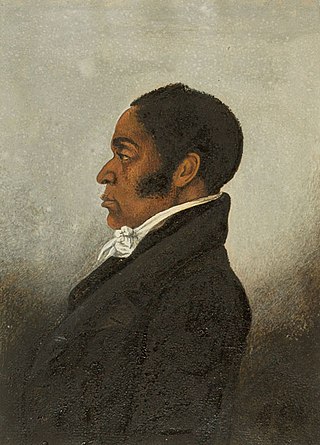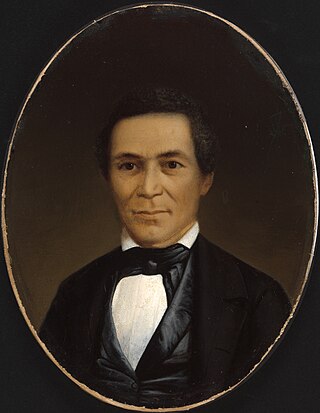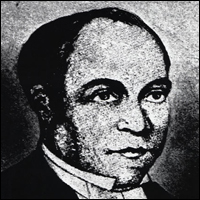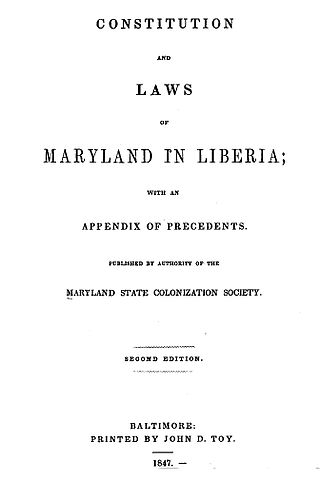
The flag of Liberia or the Liberian flag, sometimes called the Lone Star, bears a close resemblance to the flag of the United States, representing Liberia's founding by former black slaves from the United States and the Caribbean. They are both part of the stars and stripes flag family.

The American Colonization Society (ACS), initially the Society for the Colonization of Free People of Color of America, was an American organization founded in 1816 by Robert Finley to encourage and support the repatriation of freeborn people of color and emancipated slaves to the continent of Africa. It was modeled on an earlier British colonization in Africa, which had sought to resettle London's "black poor".

Samuel Eli Cornish was an American Presbyterian minister, abolitionist, publisher, and journalist. He was a leader in New York City's small free black community, where he organized the first congregation of black Presbyterians in New York. In 1827 he became one of two editors of the newly founded Freedom's Journal, the first black newspaper in the United States. In 1833 he was a founding member of the interracial American Anti-Slavery Society.

James Forten was an American abolitionist and businessman in Philadelphia, Pennsylvania. A free-born African American, he became a sailmaker after the American Revolutionary War. Following an apprenticeship, he became the foreman and bought the sail loft when his boss retired. Based on equipment he himself had developed, he established a highly profitable business. It was located on the busy waterfront of the Delaware River, in an area now called Penn's Landing.

Theodore Sedgwick Wright (1797–1847), sometimes Theodore Sedgewick Wright, was an African-American abolitionist and minister who was active in New York City, where he led the First Colored Presbyterian Church as its second pastor. He was the first African American to attend Princeton Theological Seminary, from which he graduated in 1828 or 1829. In 1833 he became a founding member of the American Anti-Slavery Society, an interracial group that included Samuel Cornish, a Black Presbyterian, and many Congregationalists, and served on its executive committee until 1840.
Ralph Randolph Gurley was an American clergyman, an advocate of the separation of the races, and a major force for 50 years in the American Colonization Society. It offered passage to free black Americans to the ACS colony in west Africa. It bought land from chiefs of the indigenous Africans. Because of his influence in fundraising and education about the ACS, Gurley is considered one of the founders of Liberia, which he named.

The Republic of Maryland was a country in West Africa that existed from 1834 to 1857, when it was merged into what is now Liberia. The area was first settled in 1834 by freed African-American slaves and freeborn African Americans primarily from the U.S. state of Maryland, under the auspices of the Maryland State Colonization Society.
The Rights of All was an African American abolitionist newspaper, founded in New York City by Samuel Cornish, a black Presbyterian minister and antislavery activist. The Rights of All replaced Freedom's Journal, the nation's first African-American newspaper, which had been founded by Cornish together with John Russwurm. Cornish had resigned from Freedom's Journal after six months, and under Russwurm's sole editorship, it reversed its opposition to the American Colonization Society to become a pro-colonizationist organ, running along these lines until Russwurm moved to Liberia in late 1829. In launching The Rights of All, Cornish reemphasized the opposition to the American Colonization Society that had been a signature theme of the early months of Freedom's Journal. Yet there was a great deal of continuity between the two publications, and The Rights of All deployed the same subscription agents, including radical abolitionist David Walker, who promoted the publication in his Appeal to the Coloured Citizens of the World. Cornish estimated that The Rights of All had about 800 subscribers, but despite this robust support, the journal survived less than a year.

John Brown Russwurm was a Jamaican-born American abolitionist, newspaper publisher, and colonist of Liberia, where he moved from the United States. He was born in Jamaica to an English father and enslaved mother. As a child he traveled to the United States with his father and received a formal education, becoming the first black person to graduate from Hebron Academy and Bowdoin College.

Mississippi-in-Africa was a colony on the Pepper Coast founded in the 1830s by the Mississippi Colonization Society of the United States and settled by American free people of color, many of them former slaves. In the late 1840s, some 300 former slaves from Prospect Hill Plantation and other Isaac Ross properties in Jefferson County, Mississippi, were the largest single group of emigrants to the new colony. Ross had freed the slaves in his will and provided for his plantation to be sold to pay for their transportation and initial costs.

African American newspapers are news publications in the United States serving African American communities. Samuel Cornish and John Brown Russwurm started the first African American periodical, Freedom's Journal, in 1827. During the Antebellum South, other African American newspapers sprang up, such as The North Star, founded in 1847 by Frederick Douglass.

The back-to-Africa movement was a political movement in the 19th and 20th centuries advocating for a return of the descendants of African American slaves to the African continent. The movement originated from a widespread belief among some European Americans in the 18th and 19th century United States that African Americans would want to return to the continent of Africa. In general, the political movement was an overwhelming failure; very few former slaves wanted to move to Africa. The small number of freed slaves who did settle in Africa—some under duress—initially faced brutal conditions, due to diseases to which they no longer had biological resistance. As the failure became known in the United States in the 1820s, it spawned and energized the radical abolitionist movement. In the 20th century, the Jamaican political activist and black nationalist Marcus Garvey, members of the Rastafari movement, and other African Americans supported the concept, but few actually left the United States.

Peter Williams Jr. (1786–1840) was an African-American Episcopal priest, the second ordained in the United States and the first to serve in New York City. He was an abolitionist who also supported free black emigration to Haiti, the black republic that had achieved independence in 1804 in the Caribbean. In the 1820s and 1830s, he strongly opposed the American Colonization Society's efforts to relocate free blacks to the colony of Liberia in West Africa.

The pre-American Civil War practice of kidnapping into slavery in the United States occurred in both free and slave states, and both fugitive slaves and free negroes were transported to slave markets and sold, often multiple times. There were also rewards for the return of fugitives. Three types of kidnapping methods were employed: physical abduction, inveiglement of free blacks, and apprehension of fugitives. The enslavement, or re-enslavement, of free blacks occurred for 85 years, from 1780 to 1865.

The trafficking of enslaved Africans to what became New York began as part of the Dutch slave trade. The Dutch West India Company trafficked eleven enslaved Africans to New Amsterdam in 1626, with the first slave auction held in New Amsterdam in 1655. With the second-highest proportion of any city in the colonies, more than 42% of New York City households enslaved African people by 1703, often as domestic servants and laborers. Others worked as artisans or in shipping and various trades in the city. Enslaved Africans were also used in farming on Long Island and in the Hudson Valley, as well as the Mohawk Valley region.

The Liberia Herald, founded in 1826 is the first newspaper ever published in Liberia which at the time was a colony. It was founded by Charles Force who died shortly after the first issue was published.
Hilary Teague, sometimes written as Hilary Teage, was a Liberian merchant, journalist, and politician in the early years of the West African nation of Liberia. A native of the state of Virginia in the United States, he was known for his oratory skills and was prominent in early Liberian colonial politics. A leading advocate for Liberian independence from the American Colonization Society, he drafted the Liberian Declaration of Independence in 1847, serving as both a senator and the first Secretary of State for the new nation in the years that followed.

The Maryland State Colonization Society was the Maryland branch of the American Colonization Society, an organization founded in 1816 with the purpose of returning free African Americans to what many Southerners considered greater freedom in Africa. The ACS helped to found the colony of Liberia in 1821–22, as a place for freedmen. The Maryland State Colonization Society was responsible for founding the Republic of Maryland in West Africa, a short lived independent state that in 1857 was annexed by Liberia. The goal of the society was "to be a remedy for slavery", such that "slavery would cease in the state by the full consent of those interested", but this end was never achieved, and it would take the outbreak of the Civil War to bring slavery to an end in Maryland.
The Cincinnati riots of 1836 were caused by racial tensions at a time when African Americans, some of whom had escaped from slavery in the Southern United States, were competing with whites for jobs. The racial riots occurred in Cincinnati, Ohio, United States in April and July 1836 by a mob of whites against black residents. These were part of a pattern of violence at that time. A severe riot had occurred in 1829, led by ethnic Irish, and another riot against blacks broke out in 1841. After the Cincinnati riots of 1829, in which many African Americans lost their homes and property, a growing number of whites, such as the "Lane rebels" who withdrew from the Cincinnati Lane Seminary en masse in 1834 over the issue of abolition, became sympathetic to their plight. The anti-abolitionist rioters of 1836, worried about their jobs if they had to compete with more blacks, attacked both the blacks and white supporters.

The African Civilization Society (ACS) was an American Black nationalist organization founded by Henry Highland Garnet and Martin Delany in New York City to serve African Americans. Founded in 1858 in response to the 1857 Supreme Court decision Dred Scott v. Sandford and a series of national events in the 1850s which negatively impacted African Americans, its mission was to exercise African-American self-determination by establishing a colony of free people of color in Yorubaland. Additionally, the organization intended the colony to Westernize Africa, combat the Atlantic slave trade, and create a cotton and molasses production economy underwritten by free labor to undermine slavery in the United States and the Caribbean. However, the majority of African Americans remained opposed to emigration programs like theirs.
















